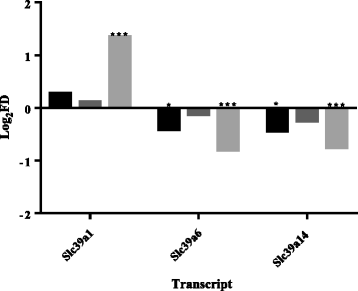Expression of the ZIP/SLC39A transporters in β-cells: a systematic review and integration of multiple datasets
- PMID: 28893192
- PMCID: PMC5594519
- DOI: 10.1186/s12864-017-4119-2
Expression of the ZIP/SLC39A transporters in β-cells: a systematic review and integration of multiple datasets
Abstract
Background: Pancreatic β-cells require a constant supply of zinc to maintain normal insulin secretory function. Following co-exocytosis with insulin, zinc is replenished via the Zrt- and Irt-like (ZIP; SLC39A) family of transporters. However the ZIP paralogues of particular importance for zinc uptake, and associations with β-cell function and Type 2 Diabetes remain largely unexplored. We retrieved and statistically analysed publically available microarray and RNA-seq datasets to perform a systematic review on the expression of β-cell SLC39A paralogues. We complemented results with experimental data on expression profiling of human islets and mouse β-cell derived MIN6 cells, and compared transcriptomic and proteomic sequence conservation between human, mouse and rat.
Results: The 14 ZIP paralogues have 73-98% amino sequence conservation between human and rodents. We identified 18 datasets for β-cell SLC39A analysis, which compared relative expression to non-β-cells, and expression in response to PDX-1 activity, cytokines, glucose and type 2 diabetic status. Published expression data demonstrate enrichment of transcripts for ZIP7 and ZIP9 transporters within rodent β-cells and of ZIP6, ZIP7 and ZIP14 within human β-cells, with ZIP1 most differentially expressed in response to cytokines and PDX-1 within rodent, and ZIP6 in response to diabetic status in human and glucose in rat. Our qPCR expression profiling data indicate that SLC39A6, -9, -13, and - 14 are the highest expressed paralogues in human β-cells and Slc39a6 and -7 in MIN6 cells.
Conclusions: Our systematic review, expression profiling and sequence alignment reveal similarities and potentially important differences in ZIP complements between human and rodent β-cells. We identify ZIP6, ZIP7, ZIP9, ZIP13 and ZIP14 in human and rodent and ZIP1 in rodent as potentially biologically important for β-cell zinc trafficking. We propose ZIP6 and ZIP7 are key functional orthologues in human and rodent β-cells and highlight these zinc importers as important targets for exploring associations between zinc status and normal physiology of β-cells and their decline in Type 2 Diabetes.
Keywords: Expression data; Microarray; RNA-seq; SLC39A; Systematic review; Type 2 diabetes; ZIP; Zinc.
Conflict of interest statement
Ethics approval and consent to participate
The King’s College Hospital Research Ethics Committee has approved human islet isolation and use for research (Protocol number 01–082, Human Islet Isolation and Research), and an assent form is completed by a relative of the cadaver pancreas donor for all islets used for research. The MIN6 cell line was a kind gift from Dr. Jun-ichi Miyazaki [101], distributed to WM under the appropriate materials transfer agreement.
Consent for publication
Not applicable
Competing interests
The authors declare that they have no competing interests.
Publisher’s Note
Springer Nature remains neutral with regard to jurisdictional claims in published maps and institutional affiliations.
Figures






Similar articles
-
Zrt-Irt-like Proteins (ZIP) Family Zinc Transporters: Emerging Players in Pancreatic β Cell Function and Insulin Regulation.J Nutr. 2025 Aug;155(8):2497-2507. doi: 10.1016/j.tjnut.2025.06.007. Epub 2025 Jun 12. J Nutr. 2025. PMID: 40516652 Review.
-
Zinc and Gastrointestinal Disorders: A Role for the Zinc Transporters Zips and ZnTs.Curr Pharm Des. 2017;23(16):2328-2332. doi: 10.2174/1381612823666170124115850. Curr Pharm Des. 2017. PMID: 28120719
-
Metallothionein and Zinc Transporter Expression in Circulating Human Blood Cells as Biomarkers of Zinc Status: a Systematic Review.Adv Nutr. 2016 Jul 15;7(4):735-46. doi: 10.3945/an.116.012518. Print 2016 Jul. Adv Nutr. 2016. PMID: 27422508 Free PMC article.
-
Zinc Transporters of the LIV-1 Subfamily in Various Cancers: Molecular Insights and Research Priorities for Saudi Arabia.Int J Mol Sci. 2025 Aug 21;26(16):8080. doi: 10.3390/ijms26168080. Int J Mol Sci. 2025. PMID: 40869403 Free PMC article. Review.
-
Oral anti-diabetic agents for women with established diabetes/impaired glucose tolerance or previous gestational diabetes planning pregnancy, or pregnant women with pre-existing diabetes.Cochrane Database Syst Rev. 2017 Oct 18;10(10):CD007724. doi: 10.1002/14651858.CD007724.pub3. Cochrane Database Syst Rev. 2017. PMID: 29045765 Free PMC article.
Cited by
-
Effects of Zinc Combined with Metformin on Zinc Homeostasis, Blood-Epididymal Barrier, and Epididymal Absorption in Male Diabetic Mice.Biol Trace Elem Res. 2025 Jan;203(1):291-304. doi: 10.1007/s12011-024-04171-y. Epub 2024 Apr 8. Biol Trace Elem Res. 2025. PMID: 38589680
-
SLC30A family expression in the pancreatic islets of humans and mice: cellular localization in the β-cells.J Mol Histol. 2018 Apr;49(2):133-145. doi: 10.1007/s10735-017-9753-0. Epub 2018 Jan 25. J Mol Histol. 2018. PMID: 29372370
-
A role for zinc transporter gene SLC39A12 in the nervous system and beyond.Gene. 2021 Oct 5;799:145824. doi: 10.1016/j.gene.2021.145824. Epub 2021 Jul 9. Gene. 2021. PMID: 34252531 Free PMC article. Review.
-
ZnT8 Haploinsufficiency Impacts MIN6 Cell Zinc Content and β-Cell Phenotype via ZIP-ZnT8 Coregulation.Int J Mol Sci. 2019 Nov 4;20(21):5485. doi: 10.3390/ijms20215485. Int J Mol Sci. 2019. PMID: 31690008 Free PMC article.
-
A novel chronic in vivo oral cadmium exposure-washout mouse model for studying cadmium toxicity and complex diabetogenic effects.Toxicol Appl Pharmacol. 2022 Jul 15;447:116057. doi: 10.1016/j.taap.2022.116057. Epub 2022 May 10. Toxicol Appl Pharmacol. 2022. PMID: 35550884 Free PMC article.
References
-
- Chabosseau P, Rutter GA. Zinc and diabetes. Arch Biochem Biophys. 2016;611:79-85. - PubMed
Publication types
MeSH terms
Substances
LinkOut - more resources
Full Text Sources
Other Literature Sources

